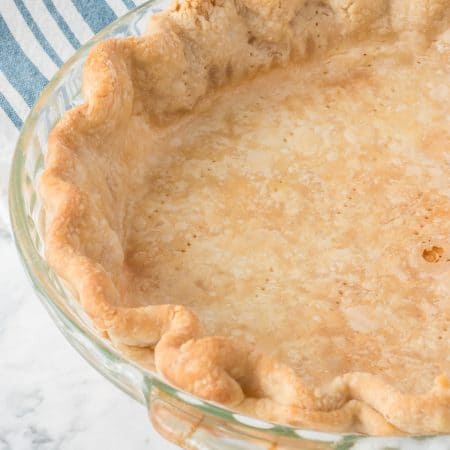
Homemade Pie Crust
pie crust
Nothing makes a pie better than using a Homemade Pie Crust! Using just five simple ingredients, this easy pie crust recipe results in a perfectly flaky crust you’ll want to use with all your pies!
Equipment
Ingredients
- 1 ½ cup all-purpose flour
- ¼ teaspoon kosher salt
- ½ cup shortening
- 3 tablespoons unsalted butter chilled
- 3-4 tablespoons cold water
Instructions
- Fill a cup with water add a bit of ice to it before starting and gathering your ingredients.
- Combine the dry ingredients (flour and salt) in a medium bowl. Add the shortening and butter to the flour mixture, then use two forks or a pastry cutter to cut it into the flour until the mixture resembles a coarse meal or peas. It should have a uniform texture but will be a combination of crumbs and small bits and pieces.
- Add the ice cold water a tablespoon at a time and stir gently with a fork or rubber spatula until the dough starts to hold together. If you add too much water, the dough will be sticky. Also, be careful not to over-mix it or it will be tough!
- Once the dough forms, shape it into a ball, wrap it tightly in plastic wrap, and then pat it down into a disc. Refrigerate it for at least 24 hours. Two hours, or a shorter amount of time or not refrigerating at all is not sufficient as the dough will be chilled on the outside and still warm inside making it sticky when you work it. A really COLD dough is SO much easier to work with and reduces its' ability to tear. Also, DO NOT allow it to warm up or come to room temperature before rolling, keep it COLD!
- When ready to roll it out, unwrap it from the plastic and place the dough on a clean work surface that's been lightly floured. Using a lightly floured rolling pin, evenly distribute hard smacks on the dough 10-15 times to make it more pliable.
- Roll the dough into a large circle about two inches larger than your pie pan. Do this by rolling a couple times from the 12 o'clock to 6 o'clock positions. Always stop rolling before you get to the edge, as doing so will make the edges too thin. Turn the dough 180 degrees and roll again from 12 to 6, lightly adding flour to your work surface, if needed. Then turn the dough 90 degrees and roll the same way. Rotating the dough will also help prevent it from sticking. If the dough is cold enough, and by working quickly and efficiently, you should only need a minimal amount of flour to keep it from sticking to your work surface and rolling pin. Adding too much flour will make the dough tough. Continue rotating 90° and rolling until you have created a circle that is at least 2-inches larger than your pie plate. If there are edges that are a bit straight, use the end of the rolling pin to curve from the middle of the dough out to the edge. Also, if cracks form at the edges, push the dough together by cupping your hand, helping to form the outer edge of the circle, and gently push towards the middle. Then roll again as directed.
- To transfer to the pie dish, roll it up and over the rolling pin or fold it in half. Drape it loosely over, then fit it into the pan by gently lifting the edges of the dough so that it settles at the bottom and along the sides, never pressing or forcing as that will tear it.
- When making a one-crust pie, do not trim the edges. Just fold the excess dough under creating a thicker base to crimp or flute the crust (see below). When making a double-crust pie, fold the top crust under the bottom overhanging crust to form your edge, and then crimp.
- Use the tines of a fork to place holes over the bottom and sides of the dough. Place into the refrigerator for at least 15 minutes to chill again before proceeding with blind-baking or fill the pie and refrigerate. The colder your dough is when it goes into the oven, the flakier it will be, and it will also help prevent shrinking as it bakes.
- Follow baking instructions according to your desired recipe.
Notes
- This recipe makes enough dough for a single pie crust. If a double pie crust is needed, then simply double the recipe and divide the dough evenly in half.
- To Blind-Bake: place a pre-formed pie parchment in the pan, and fill with ceramic pie weights, so that the crust stays flat when baking.
- See post for additional tips and details.
Nutrition
Serving: 1pie crust | Calories: 1589kcal | Carbohydrates: 143g | Protein: 19g | Fat: 104g | Saturated Fat: 26g | Polyunsaturated Fat: 30g | Monounsaturated Fat: 42g | Trans Fat: 13g | Sodium: 591mg | Potassium: 201mg | Fiber: 5g | Sugar: 1g | Calcium: 31mg | Iron: 9mg